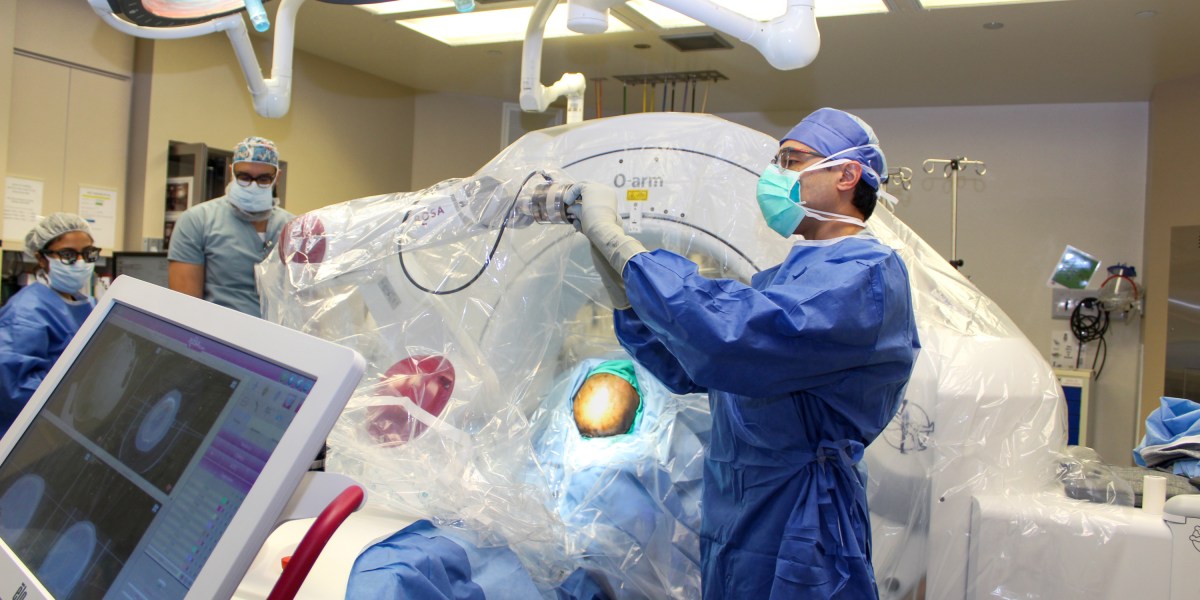Neuroscientists have created a mood decoder that can measure depression
John’s life changed forever when he broke up with his girlfriend. The breakup sent him into a downward spiral, and led to his first depressive episode when he was 27 years old. “At first it’s just extreme sadness … then you start losing sleep,” says John (not his real name), who spoke on condition of anonymity. He developed crippling anxiety and experienced panic attacks and dark thoughts that eventually led him to attempt to end his own life.
Drugs didn’t work for John—he says he has tried pretty much every antidepressant, antipsychotic, and sedative out there. And while electroconvulsive therapy—a treatment that delivers electrical stimulation to one or both sides of a person’s head—eventually pulled him out of his first depressive episode, it didn’t touch the symptoms of his second episode, which started around five years later.
But as part of a clinical trial, John has benefited from an experimental treatment that involves inserting electrodes deep into his brain to deliver regular pulses of electricity. Deep brain stimulation is already used to treat severe cases of epilepsy and a few movement disorders such as Parkinson’s. But depression is more complicated—partly because we still don’t fully understand what’s going on in the brain when it occurs.
“Depression is a complex illness,” says Patricio Riva Posse, a neurologist at the Emory School of Medicine in Atlanta, Georgia, who was not involved in the trial. “It’s not like trying to correct one tremor—there’s a whole universe of symptoms.” These include low mood, suicidality, inability to experience pleasure, and changes in motivation, sleep, and appetite.
Doctors have been using electricity to treat brain disorders—including depression—for decades, and some studies have found that electrodes placed deep inside the brain can jolt some people out of their symptoms. But results vary. Neuroscientists hope that by getting a better idea of what’s happening inside the brains of people with symptoms like John’s, they can make the treatment more effective.
John is one of five people who have volunteered to have their brains probed as part of a clinical trial. At the start of 2020, he had a total of 14 electrodes implanted across his brain. For nine days, he stayed in a hospital with protruding cables wrapped around his head, while neuroscientists monitored how his brain activity correlated with his mood.
The researchers behind the trial say they have developed a “mood decoder”—a way of being able to work out how someone is feeling just by looking at brain activity. Using the decoder, the scientists hope to be able to measure how severe a person’s depression is, and target more precisely where the electrodes are placed to optimize the effect on the patient’s mood. So far, they have analyzed the results of three volunteers.
What they have found is extremely promising, says Sameer Sheth, a neurosurgeon based at Baylor College of Medicine in Houston, Texas, who is leading the trial. Not only have he and his colleagues been able to link volunteers’ specific brain activity with their mood, but they have also found a way to stimulate a positive mood. “This is the first demonstration of successful and consistent mood decoding of humans in these brain regions,” says Sheth. His colleague Jiayang Xiao presented the findings at the Society for Neuroscience’s annual meeting in San Diego in November.
Zapping depression
Deep brain stimulation (DBS) usually involves placing one or two electrodes deep into the brain to deliver pulses of electricity to specific regions. It can work really well for some people with Parkinson’s disease, where it’s used to stimulate areas that control movement. Researchers are exploring whether it might also help treat psychiatric issues including obsessive-compulsive disorder, eating disorders, and depression.
A handful of studies performed in the early and mid 2000s suggested that DBS could help people with depression that didn’t respond to typical treatments, like antidepressants. But initial results of two large clinical trials were disappointing, and the tests were stopped early.
It’s not clear why these trials didn’t see the same results as earlier studies. But the varying success rates might have something to do with how the brain stimulation is delivered. Several brain regions are thought to play a role in depression. And there are lots of potential ways to deliver electrical pulses. “We don’t know how to deliver DBS intelligently to any given individual [with depression],” says Sheth. “This is just a very immature therapy.”
Sheth has been trying to figure out what might work best. He and his colleagues have borrowed a brain surgery approach that is sometimes used to help people with epilepsy who don’t get better with drugs.
In these cases, doctors might implant electrodes across the person’s brain in order to find out where the seizures are starting. Once identified, these regions can either be stimulated with electrodes or removed entirely.
Depression doesn’t originate from a single point in the brain, the way a seizure does. But Sheth and his colleagues are taking the same approach—temporarily implanting electrodes across the brain to monitor brain activity—for insight into the condition.
The team is particularly interested in how patterns of brain activity differ when a person is feeling better or especially low. Sheth and his colleagues are also experimenting with stimulation—what level, type, and frequency works best to get the brain back to a positive mood state? Armed with this information, neurosurgeons will be in a much better position to help people with depression, and deep brain stimulation is more likely to work, says Sheth.
Back online
John was the first trial volunteer to undergo the procedure. Sheth and his colleagues put him under general anesthetic before drilling holes into his skull to insert the electrodes. The team implanted two DBS electrodes on each side of the brain in regions thought to be involved in symptoms of depression. An additional five temporary electrodes were placed on each side of the brain to monitor John’s activity in regions linked to mood and cognition.
To find the right place to stimulate, the team needed to wake John up during his operation. He remembers being repeatedly asked how he felt as surgeons probed his brain with electrodes. “Then they hit a spot and I said: ‘I actually feel back online,’” he says. “Depression is like a constant weight on your soul. When they touched that perfect little spot, that weight lifted.”
He remembers hearing the doctors laugh and tell him they’d found the right place, and then falling back asleep.
John woke up “with a headache like nothing ever before” and spent the next nine days being closely monitored by Sheth and his colleagues. Every few hours, the medical team would ask him questions about his mood and how he was feeling.
At the end of the nine days, the team removed the 10 monitoring electrodes from John’s brain but left in the four DBS electrodes. These electrodes were connected to a rechargeable battery implanted in John’s chest. In the years since, the pulses of stimulation have been tweaked slightly. Six months after the operation, the team turned off the stimulation without telling John. His symptoms immediately worsened. “It was obvious,” he says. “I told them: ‘I don’t know what you did, but I can’t sleep, I’m anxious … it’s not working.”
The device was switched back on and has been running ever since. Sheth’s team has carried out the same procedure in four other people so far—all of them with severe, treatment-resistant depression. They plan to study 12 people in total.
Despite the early signs of success, Sheth and his colleagues don’t plan to carry out this same procedure more widely. Temporarily implanting 10 electrodes into the brain provides insight into a specific person’s depression, but it isn’t a practical approach for a condition that affects almost 3 million people in the US alone. It is an invasive, expensive procedure that takes a lot of time and carries risks.
Instead, Sheth hopes to find trends among his 12 volunteers and use these to develop an improved form of DBS that can help anyone who needs it. “We’re hoping that there are some generalizable findings that we get out of this,” he says.
Sheth and his colleagues have analyzed brain recordings from only three people so far, but they are already seeing trends. A brain region called the cingulate cortex fires in a certain way when all three are in a better mood and shows the opposite pattern of activity when the volunteers are experiencing a low mood, says Sheth.
Riva Posse says that the results are “very encouraging.” We are starting to understand that “there are signals of depression that seem to be pretty consistent across the board,” he says. “This is going to advance, considerably, the understanding of depression and help come up with … neurostimulation approaches.”
Still, it is still too soon to say whether these findings will track across a larger group of people. “It’s only three patients,” says Darin Dougherty, a psychiatrist at Mass General Research Institute in Boston who specializes in neurosurgery for depression.
Dougherty thinks that Sheth’s research is “essential.” He adds, “Hopefully they can get enough data from a small group of people so that we can move away from [implanting multiple temporary electrodes].” He predicts that Sheth’s approach might identify a brain region that will be worth targeting in most people with treatment-resistant depression, and that noninvasive brain scans will find the exact spot to implant the electrode.
Measuring mood
Sheth and his colleagues also found some differences among the three volunteers, and the team’s “mood decoder” could identify how each volunteer was feeling based on their brain activity.
He hopes that in the future, new technologies will allow him and others to collect this information noninvasively, perhaps using a device that sits on a person’s head. Such a device could be used to measure the severity of a person’s symptoms, he says.
Today, a person with symptoms of depression will typically be asked a series of questions to determine the severity of the condition. Having some kind of objective measure—such as readings from a brain scan—is a key goal for psychiatry, says Dougherty.
It could also be problematic, though. Brain scans might never be sensitive enough to account for individual differences in people’s brains when it comes to symptoms of depression, and they might miss signs in some people and overestimate them in others. Sheth also acknowledges the possibility that because of research like his, brain scans could one day be used to diagnose depression in someone who is not obviously unwell or reveal it in someone who doesn’t want it known.
John, for one, doesn’t want others—particularly potential employers—to know he has a history of depression. “People don’t understand depression, and unfortunately, they see it as a weakness,” he says.
“You can’t really argue that… we should not try to help all these millions and millions of people with depression… just because there’s a possibility of misuse,” says Sheth. “We have to find ways of helping these folks. The rest of society can help us put guardrails on how this technology should be used.”
John’s electrodes are still delivering pulses of electrical stimulation deep in his brain. He charges the battery embedded in his chest every week. “As far as I know, if the stimulation stops, I go back to square one,” he says. And while DBS might not work for everyone for depression, “it saved my life,” he says.




